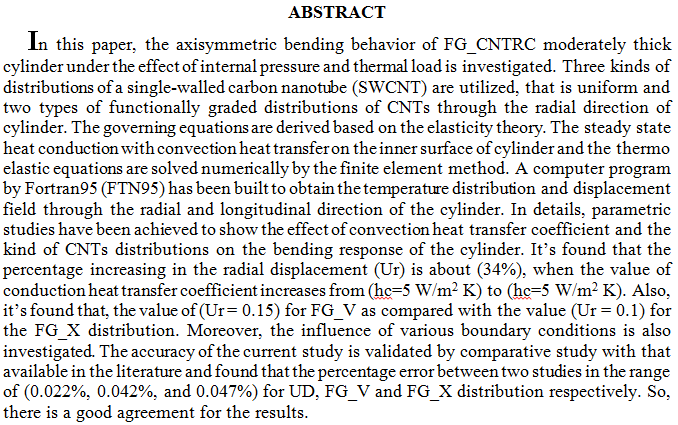
Background: This study was conducted to assess the effects of various beverages on the shear bond strength of light-cured orthodontic composite used to bond stainless steel orthodontic brackets on human teeth and to determine the site of bonding failure of this material. Materials and Methods: Fifty extracted human premolars were selected and randomly divided into five equal groups each with 10 teeth according to the beverage type (Control, One Tiger, Milk, Green tea and Coffee). After bonding, the teeth were immersed in specific beverages for 5 minutes twice daily with equal intervening intervals then washed and stored in distilled water at 37º C for the reminder of the day. The process was carried out for 30 days. The samples were then
... Show MoreBackground: Poly-ether-ether-ketone(PEEK) has been introduced to many dental fields. Recently it was tested as a retainer wire‎ following orthodontic treatment. This study aimed to investigate the effect of changing the bonding spot size and location on the performance of PEEK retainer wires. Methods: A biomechanical study involving four three-dimensional finite element models was performed. The basic model was with a 0.8 mm cylindrical cross-section PEEK wire, bonded at the center of the lingual surface of the mandibular incisors with 4 mm in diameter composite spots. Two other models were designed with 3 mm and 5 mm composite sizes. The last model was created with the composite bonding spot of the canine away from the center
... Show More (7)
(7)
 (8)
(8)
Background: Poly-ether-ether-ketone(PEEK) has been introduced to many dental fields. Recently it was tested as a retainer wire‎ following orthodontic treatment. This study aimed to investigate the effect of changing the bonding spot size and location on the performance of PEEK retainer wires. Methods: A biomechanical study involving four three-dimensional finite element models was performed. The basic model was with a 0.8 mm cylindrical cross-section PEEK wire, bonded at the center of the lingual surface of the mandibular incisors with 4 mm in diameter composite spots. Two other models were designed with 3 mm and 5 mm composite sizes. The last model was created with the composite bonding spot of the canine away from the center of t
... Show More (10)
(10)
 (9)
(9)
Background: Dental erosion is a common oral condition which results due to consumption of high caloric and low pH acidic food such as carbonated drinks and fruit juices. It is expected that these food types can cause irreversible damage to dental hard tissues and early deterioration of the dental restorations. So, this study aimed to evaluate and compare the erosive potential effects of orange fruit juice and Miranda orange drink on the microhardness of an orthodontic composite material. Materials and methods: Thirty discs with a thickness of 2 mm and a diameter of 10 mm were prepared from orthodontic bonding composite. The prepared discs were equally divided into three groups (n=10). Microhardness analysis was carried out both prior to
... Show MoreProbit analysis is a type of regression used to analyze the relationship between a stimulus and the quantal response. Allelopathy refers to direct or indirect negative or positive effects of one plant on another through the release of chemical compounds into the environment. This study was carried out to apply probit analysis in investigating the allelopathic effects of the leaves aqueous extracts of apple of Sodom [Calotropis procera (Aiton) W.T.] on the inhibition of seed germination of African rattlebox (Crotalaria saltiana Andr.). A laboratory experiments were carried out at the Faculty of Agricultural Sciences, University of Gezira, Sudan in season 2014/15. Ten concentrations (2.3, 4.6
... Show MoreOne of the most important techniques for preparing nanoparticle material is Pulsed Laser Ablation in Liquid technique (PLAL). Carbon nanoparticles were prepared using PLAL, and the carbon target was immersed in Ultrapure water (UPW) then irradiated with Q-switched Nd:YAG laser (1064 nm) and six ns pulse duration. In this process, an Nd:YAG laser beam was focused near the carbon surface. Nanoparticles synthesized using laser irradiation were studied by observing the effects of varying incident laser pulse intensities (250, 500, 750, 1000) mJ on the particle size (20.52, 36.97, 48.72, and 61.53) nm, respectively. In addition, nanoparticles were characterized by means of the Atomic Force Microscopy (AFM) test, pH easurement
... Show More (2)
(2)
In the present study, the growth and total lipid contents of two oleaginous fungal isolates Aspergillus terreus, Aspergillus fumigatus were compared in different nitrogen and organic carbon sources. Artificially the fungi were cultured on media consisting of various mono- or di- or polysaccharides and peptone or yeast extract as elementary sources for carbon and nitrogen, respectively. Media containing sucrose /yeast extract or glucose/ yeast extract were the most effective for lipid production from fungal, during two weeks incubation period, the highest biomass of dry weight was (19.6 , 18.8) g / L , (25.8 , 30.5) g /L and lipid yield (1, 0.97 )g/L, (0.65, 0.65) g/ L for two isolates Aspergillus terreus
... Show More (3)
(3)
 (2)
(2)
Antibacterial activity of CNSs against Staphylococcus aureus and Escherichia coli was estimated. Higher inhibition zone of 18 mm and 20 mm were observed against S. aureus and E.coli, respectively, at a concentration of 2 mg/ml of carbon nanosphere after 24 hrs of incubation at 37 ºC. In vitro cytotoxicity experiment was performed on two parasite strains of Leishmania donovani and Leishmania tropica by using MTT assay. L. donovani revealed more sensitiv to the CNSs than L. tropica. An intermediate level of cytotoxicity of 51.31 % was observed when 2.4 mg/ml of CNSs was incubated with L. donovani, while weak cytotoxicity of 37.20 % was shown when the
... Show More (1)
(1)
